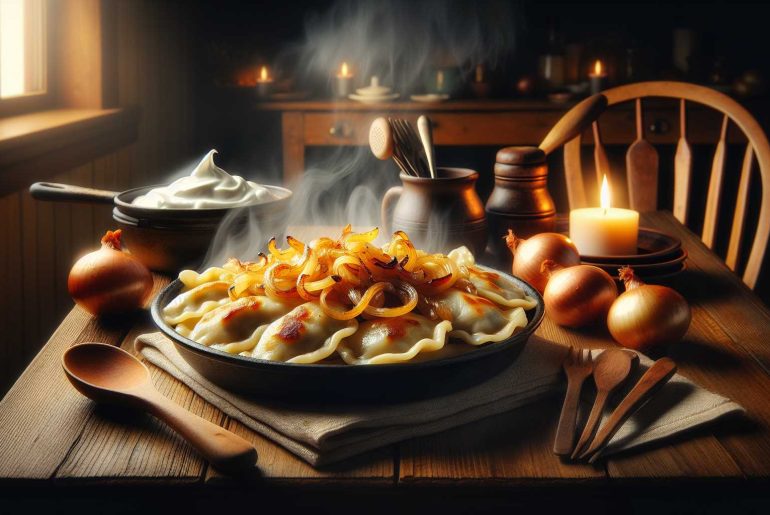
Polish perogies are a key part of Eastern European food, known for their soft dough and delicious fillings. These dumplings go way back in history and have become a significant part of Poland’s cultural and culinary traditions.
Over time, perogies have seen a variety of fillings, both traditional and new. They’re not just about their history or how they’re made; perogies also allow for creativity in how they’re cooked, served, and combined with other foods.
Getting into making perogies is more than following a recipe; it’s like taking a trip through a culture that continues to delight and comfort people everywhere.
History of Polish Perogies
Pierogi, a staple in Polish cuisine, traces its roots back to the 13th century. This dish, which has become a symbol of Polish heritage, was likely influenced by culinary practices from the Far East, introduced through trade. When pierogi first appeared in Poland, they were more than just a new food item; they marked the beginning of a unique Polish culinary identity. Over the years, pierogi have become deeply embedded in Polish culture, celebrated in both daily life and special occasions. They’ve evolved while still retaining their importance as a representation of national pride and cultural continuity.
The story of pierogi is not just about food; it’s about how a simple dish can bring people together and tell the history of a nation. For example, during holidays or family gatherings, making pierogi is a communal activity that everyone participates in. It’s a time for sharing stories, passing down traditions, and of course, enjoying delicious food. Moreover, pierogi come in various fillings, reflecting the diversity and creativity of Polish cooking. From savory options like meat, potato, and cheese, to sweet versions filled with fruits, there’s a pierogi for every taste preference.
In today’s world, where global cuisine is more accessible than ever, pierogi have found fans beyond Poland’s borders. Many restaurants and food festivals around the world celebrate this Polish delicacy, offering traditional recipes alongside new, innovative variations. For those looking to try making pierogi at home, there are plenty of cookbooks and online tutorials that provide step-by-step guidance, making it easy to bring a taste of Poland into your kitchen.
Traditional Perogy Fillings
Diving into Polish culinary traditions, we find perogies at the heart, showcasing the rich flavors and agricultural heritage of Poland. The classic perogy filling combines mashed potatoes and farmer’s cheese, creating a creamy and slightly tangy delight that’s both simple and delicious. It’s a perfect example of how basic ingredients can produce comforting and satisfying food.
Another popular filling option includes sautéed onions and mushrooms. This combination adds a robust, earthy flavor to the perogies, making them a satisfying choice for a hearty meal. It demonstrates the culinary creativity in Poland, turning everyday ingredients into a dish full of depth and flavor.
For those who prefer sweet over savory, perogies filled with fruits like tart cherries or sweet blueberries are a treat. These fillings capture the taste of Polish summers, offering a delightful dessert option or a sweet main course. It’s a testament to the versatility of perogies, proving they can satisfy a wide range of taste preferences.
Perogies are a staple in Polish cuisine for good reason. They’re not only versatile, allowing for a range of fillings from savory to sweet, but they also embody the agricultural richness and culinary innovation of Poland. Whether you’re enjoying a plate of potato and cheese perogies or indulging in a fruit-filled version, you’re experiencing a piece of Polish culinary heritage.
Cooking Techniques Explained
To make great perogies, understanding the traditional cooking methods of Poland is essential. Let’s start with boiling. This method cooks perogies gently until they float, indicating they’re done. Boiling keeps the dough soft and the fillings, whether savory or sweet, intact.
Now, if you’re after a bit of crunch, frying is your go-to. It gives the perogies a golden, crispy outside, which contrasts nicely with the soft inside. Frying also brings out a deeper flavor, making the filling even more delicious.
Each cooking method, boiling or frying, respects tradition while allowing for personal taste. This flexibility ensures that perogies can be a favorite for everyone, showcasing the dish’s versatility and its cultural importance in Poland.
For those looking to try this at home, a good non-stick pan can make frying perogies easier, ensuring they get that perfect golden crisp without sticking. On the other hand, a large, sturdy pot is best for boiling, giving the perogies plenty of room to float to the top when they’re ready.
Serving and Pairing Ideas
Perogies offer a versatile dining option that can elevate any meal with the right pairings. These dough pockets, filled with potato, cheese, or fruit, serve as a blank slate for culinary creativity. A simple yet classic way to enjoy them is with sour cream and crispy bacon bits on top. This combination adds a creamy texture and a salty flavor, enhancing the perogies’ taste. For those looking to balance the richness, adding caramelized onions or a tangy apple-cider vinegar slaw can provide a refreshing contrast.
For those eager to experiment, a light drizzle of truffle oil or a sprinkle of smoked paprika over the perogies can introduce new flavors. Truffle oil adds an earthy richness, while smoked paprika brings a subtle warmth and smokiness, making each bite more interesting.
When choosing products to pair with perogies, consider the filling. For potato and cheese-filled perogies, a crisp white wine or light beer can complement their flavors well. If you’re serving fruit-filled perogies, a dollop of whipped cream or a scoop of vanilla ice cream can turn them into a delightful dessert.
Crafting Your Own Perogies
Making your own perogies is an engaging way to dive into Polish cuisine. This journey begins with preparing a soft and durable dough. It’s essential to achieve the right consistency to ensure your perogies don’t fall apart during cooking. For the filling, you have a wide range of options. You can go traditional with a potato and cheese mix or experiment with sweet fillings like apples mixed with cinnamon. The key is to choose ingredients that complement each other well, creating a delicious filling that’s encased in the dough.
The process of making perogies might seem complex at first, but it’s actually quite straightforward once you get the hang of it. First, you need to prepare the dough and let it rest. While it’s resting, you can focus on making your filling. This could be as simple as mashing boiled potatoes with some cheese, or combining your favorite fruits with a dash of spice for a sweet version. Once your filling is ready, roll out the dough, cut it into circles, place a spoonful of filling in each, and then fold and seal them. Boiling and then optionally frying or baking the perogies brings them to perfection.
For those looking to dive into making perogies at home, investing in a perogy maker can simplify the process. This tool helps in cutting uniformly shaped dough and can assist in sealing the perogies more efficiently.
This cooking adventure not only allows you to explore an integral part of Polish culinary tradition but also gives you the freedom to tailor the recipes to your taste. Whether sticking to classic fillings or inventing your own, the act of making perogies is a rewarding experience that brings a taste of comfort and creativity to your kitchen.
Conclusion
To sum it up, Polish cuisine truly shines with the simple yet delicious perogy. This dish isn’t just food; it’s a piece of Poland’s history and traditions.
By diving into the various fillings, ways to cook them, and how to serve them, you really start to appreciate how versatile and important perogies are.
Plus, making perogies at home is more than just cooking; it’s a way to keep Polish traditions alive and bring people closer to their cultural roots.







Comments are closed.